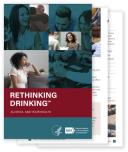The table below shows the approximate number of standard drinks (or alcoholic drink equivalents) found in common containers.
| Regular Beer (5% alc/vol) | Malt Liquor (7% alc/vol) | Table Wine (12% alc/vol) | 80-proof Distilled Spirits1 (40% alc/vol) |
|---|---|---|---|
12 fl oz = 1 16 fl oz = 1⅓ 22 fl oz = 2 40 fl oz = 3⅓ | 12 fl oz = 1½ 16 fl oz = 2 22 fl oz = 2½ 40 fl oz = 4½ | 750 ml (a regular wine bottle) = 5 | A shot (1.5-oz glass/50-ml bottle) = 1 A mixed drink or cocktail = 1 or more 200 ml (a "half pint") = 4½ 375 ml (a "pint" or "half bottle") = 8½ 750 ml (a "fifth") = 17 |
The examples above serve as a starting point for comparison. For different types of beer, wine, or malt liquor, the alcohol content can vary greatly. Some differences are smaller than you might expect, however. Many light beers, for example, have almost as much alcohol as regular beer—about 85% as much, or 4.2% versus 5.0% alcohol by volume (alc/vol), on average.
Although the U.S. standard drink (alcoholic drink equivalent) amounts are helpful for following health guidelines, they may not reflect customary serving sizes. In addition, while the alcohol concentrations listed are "typical," there is considerable variability in alcohol content within each type of beverage.
Do you drink cocktails or a beverage containing alcohol not listed above? If you’re curious and willing to do a little research on your beverage’s alcohol content, you can use Rethinking Drinking's calculators to estimate the number of U.S. standard drinks (alcoholic drink equivalents) in a cocktail or container.
1 Distilled spirits include vodka, whiskey, gin, rum, and tequila.



